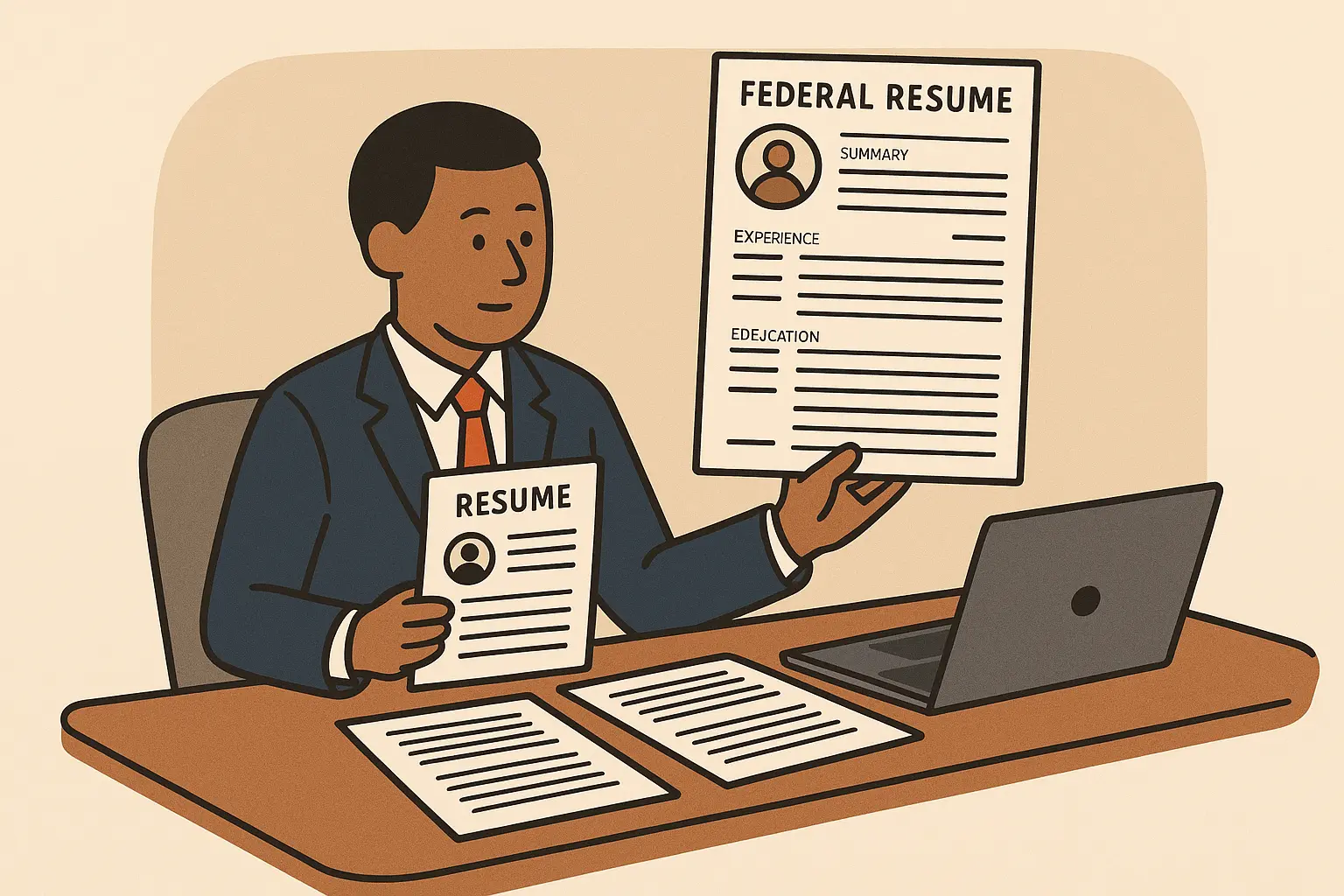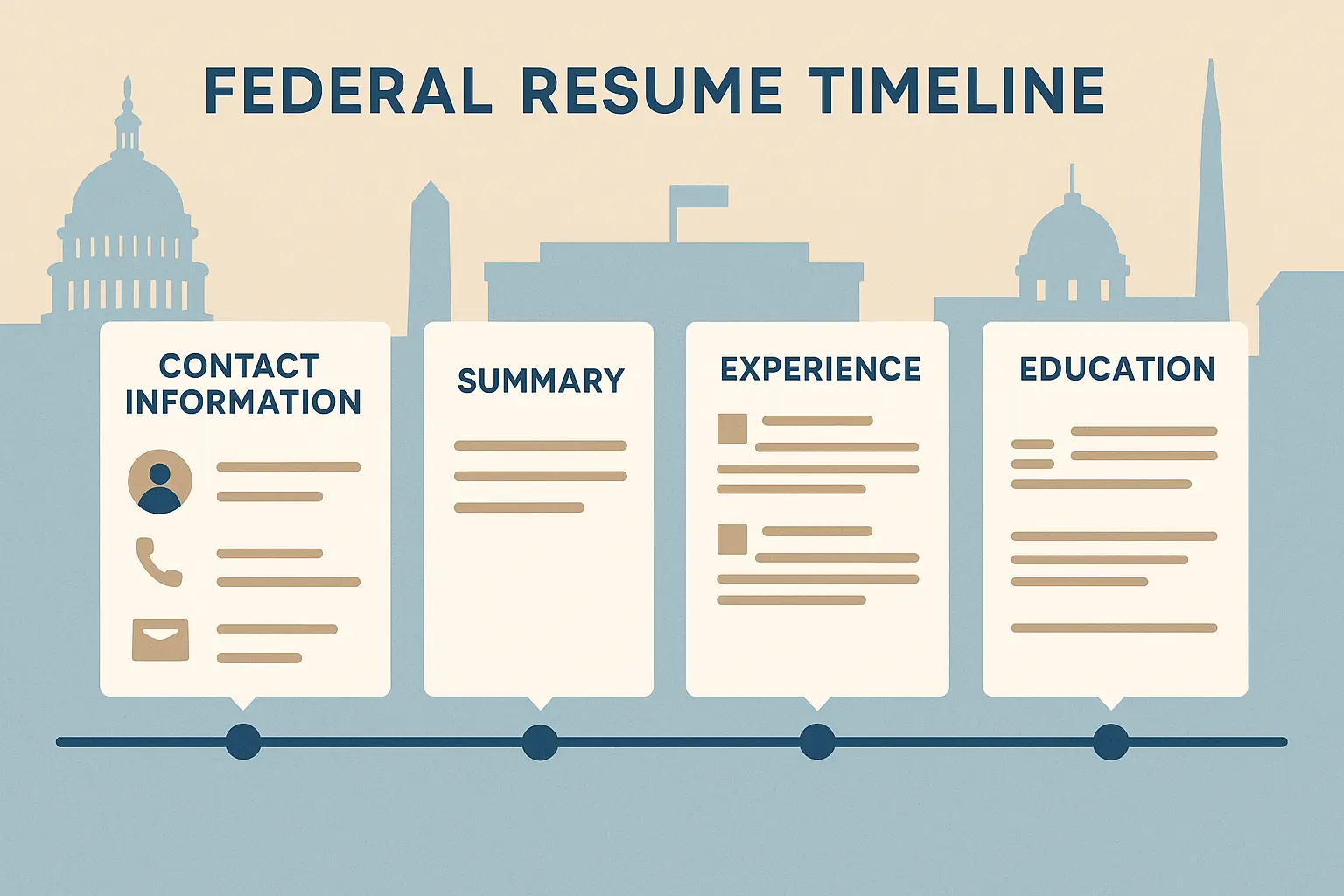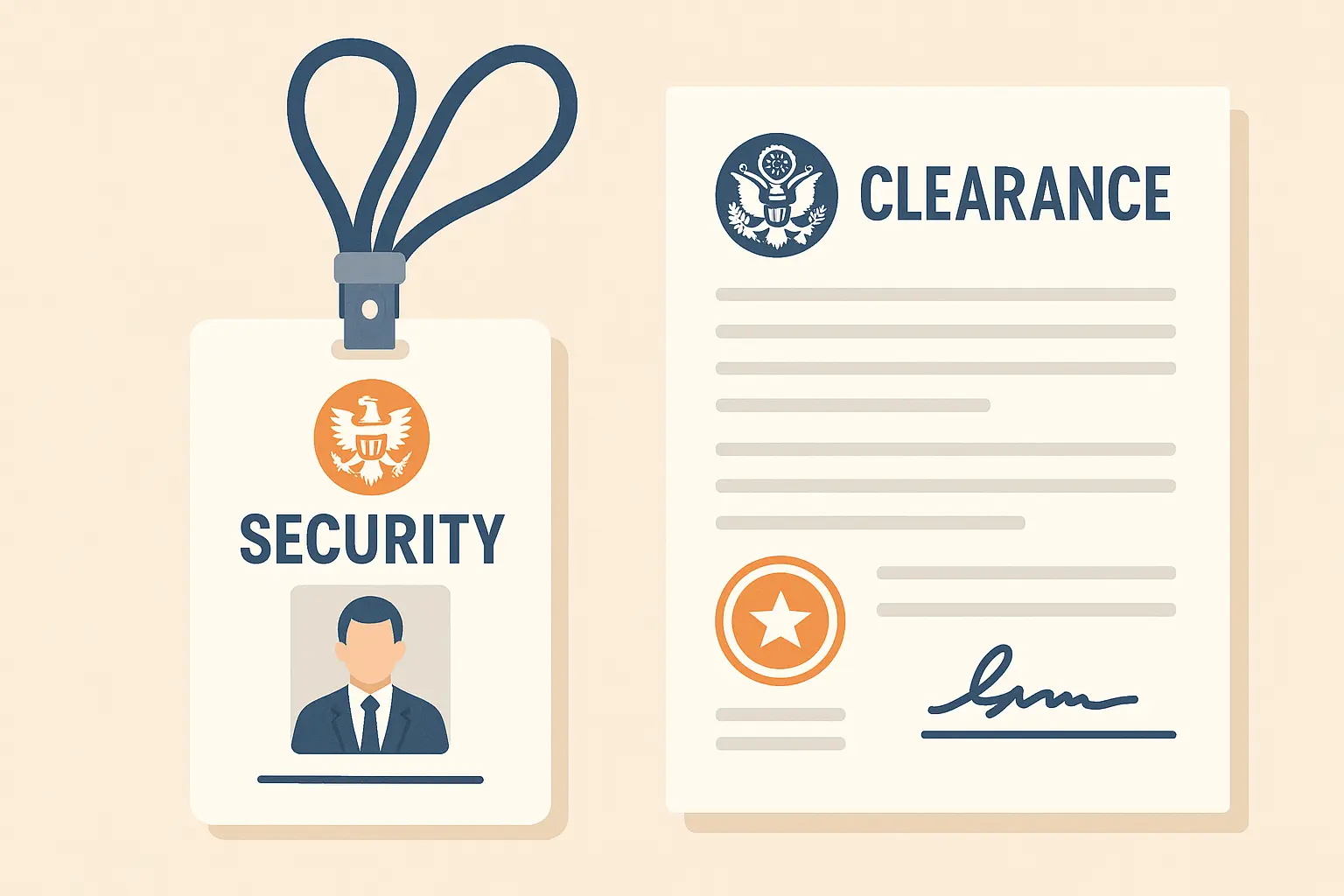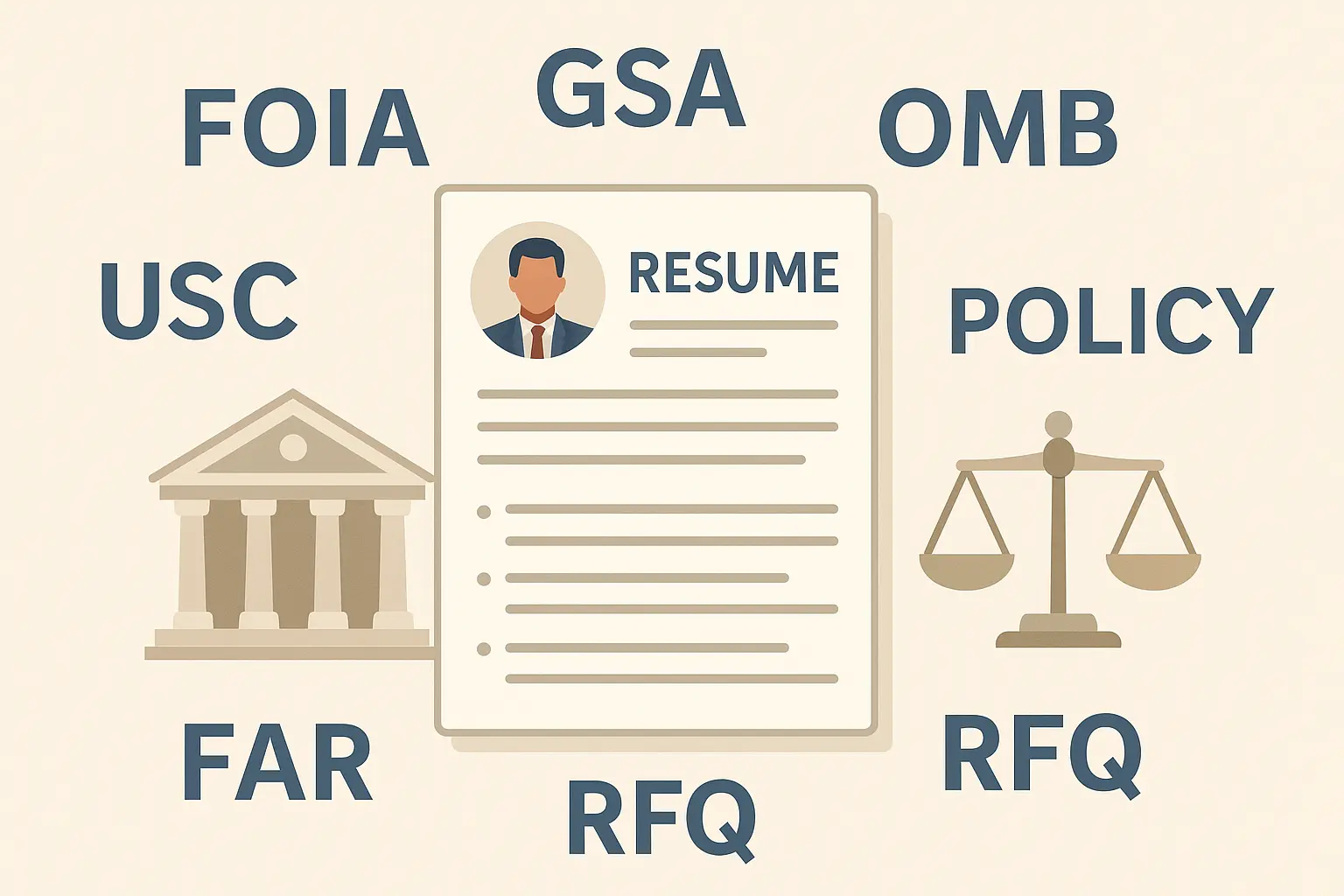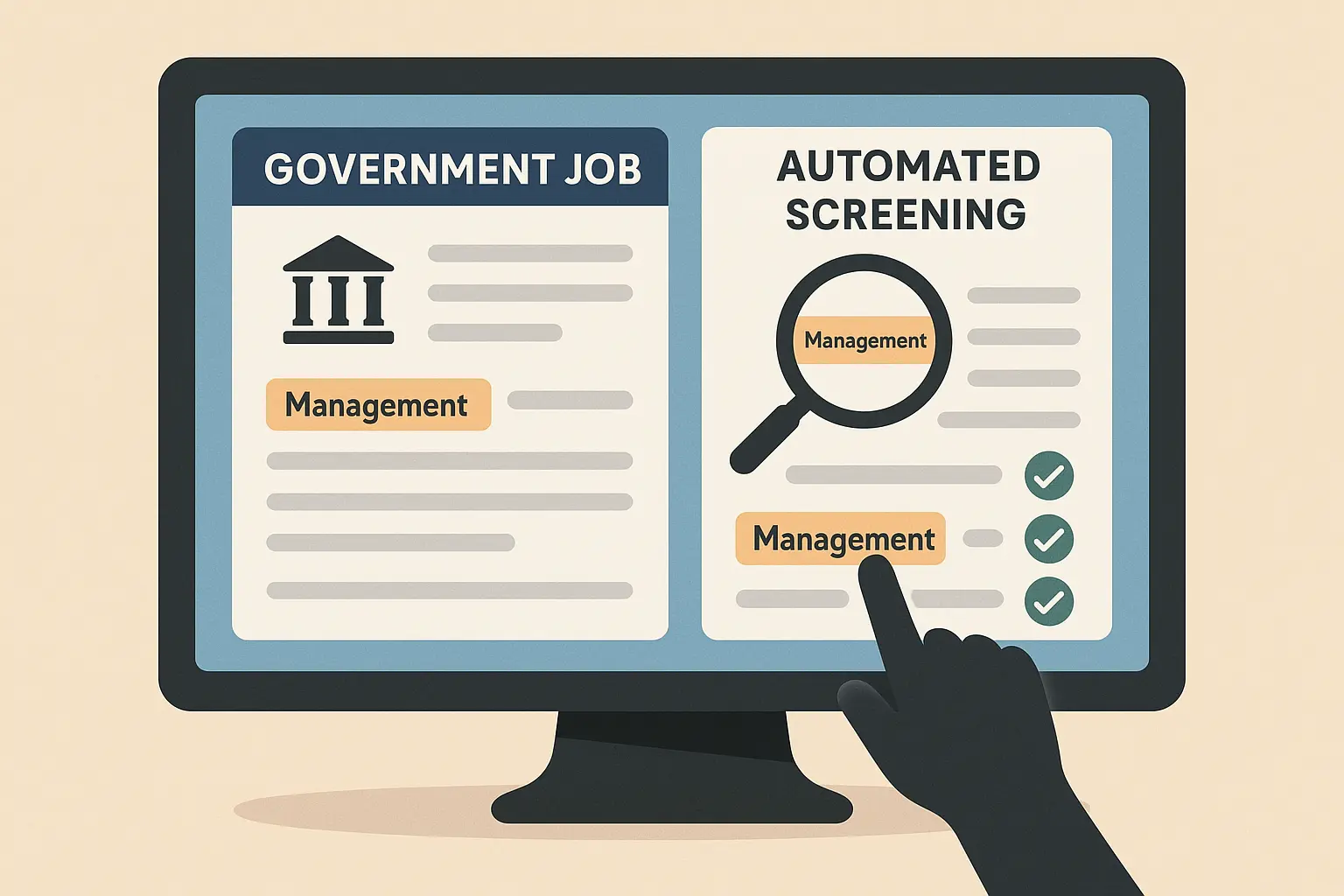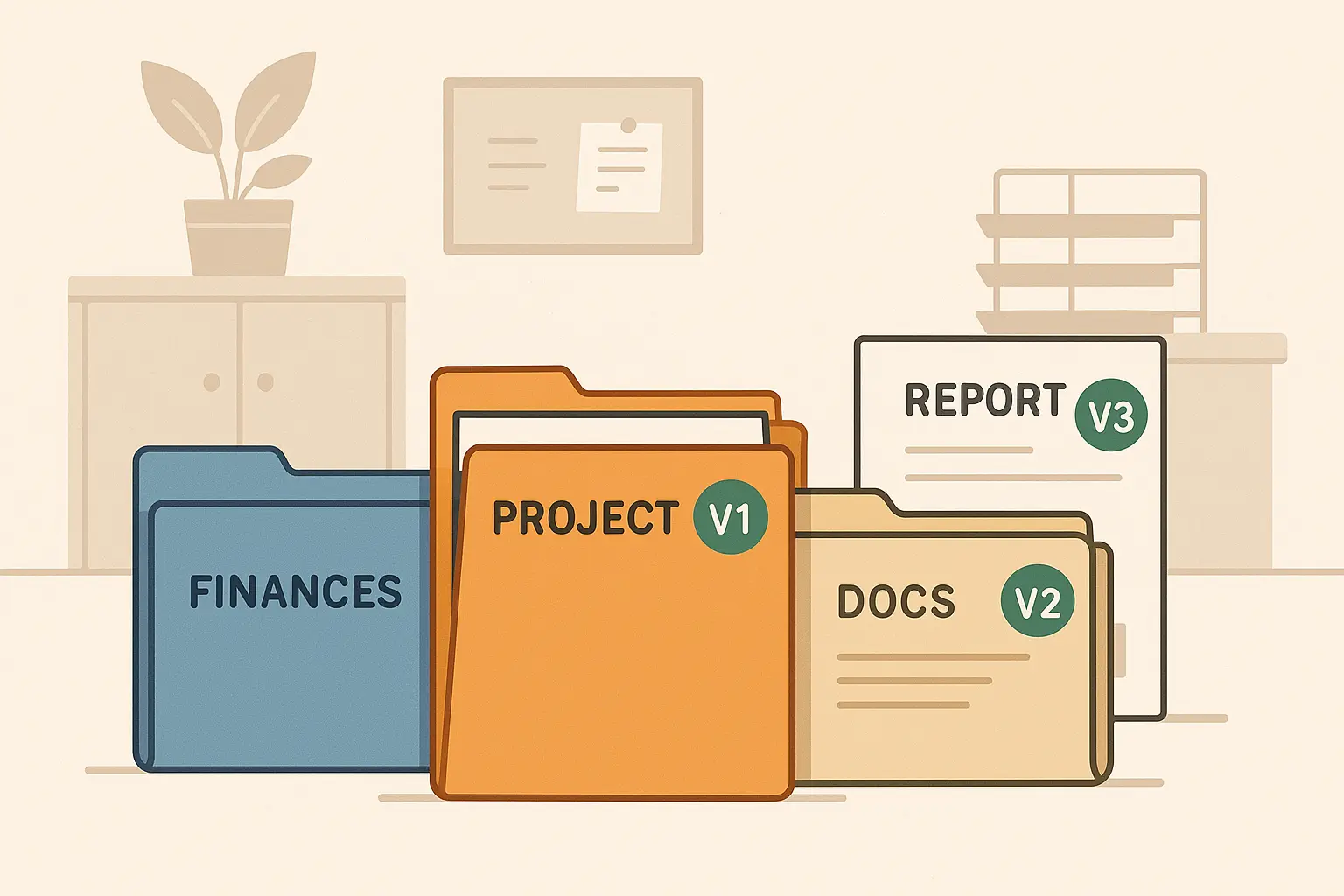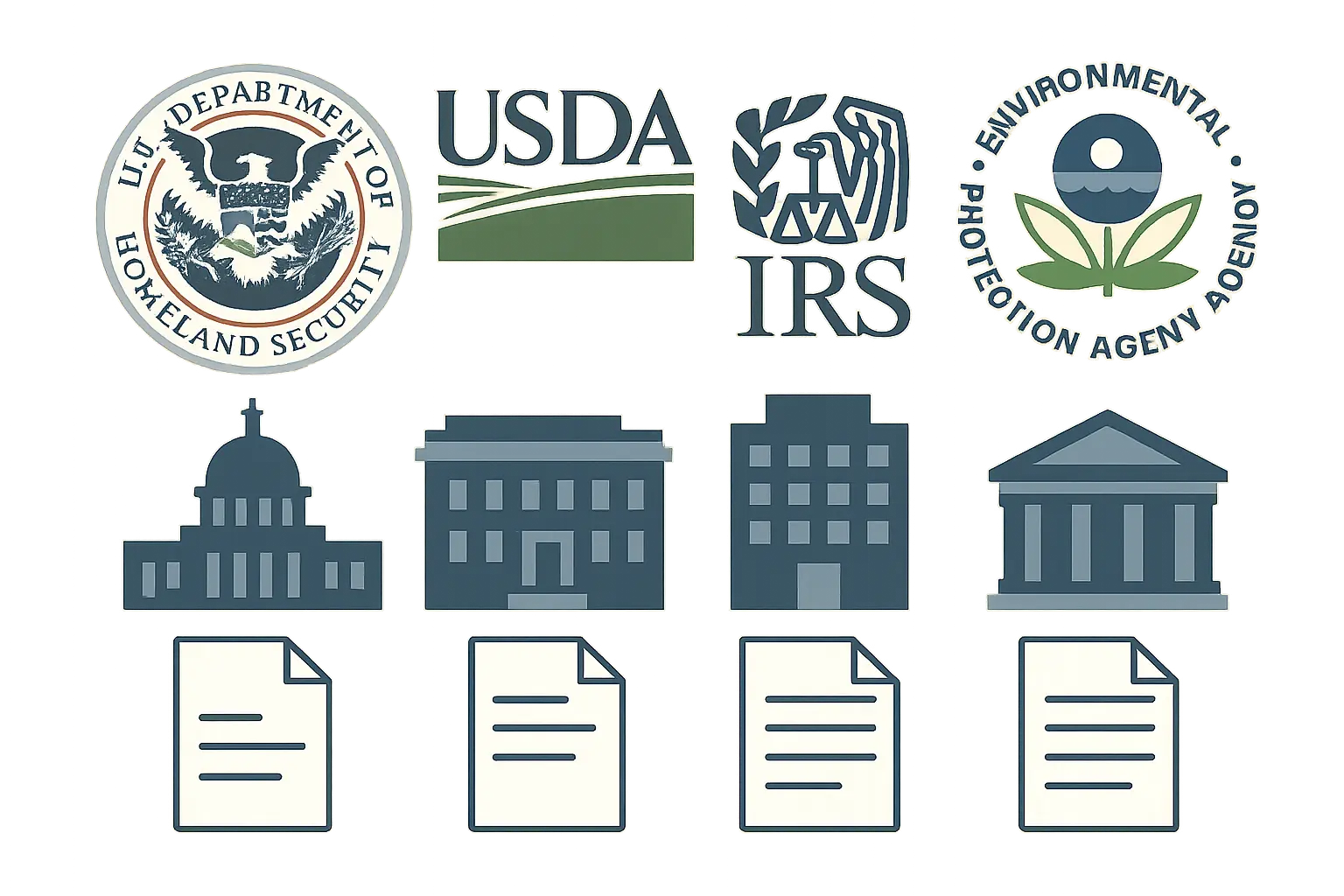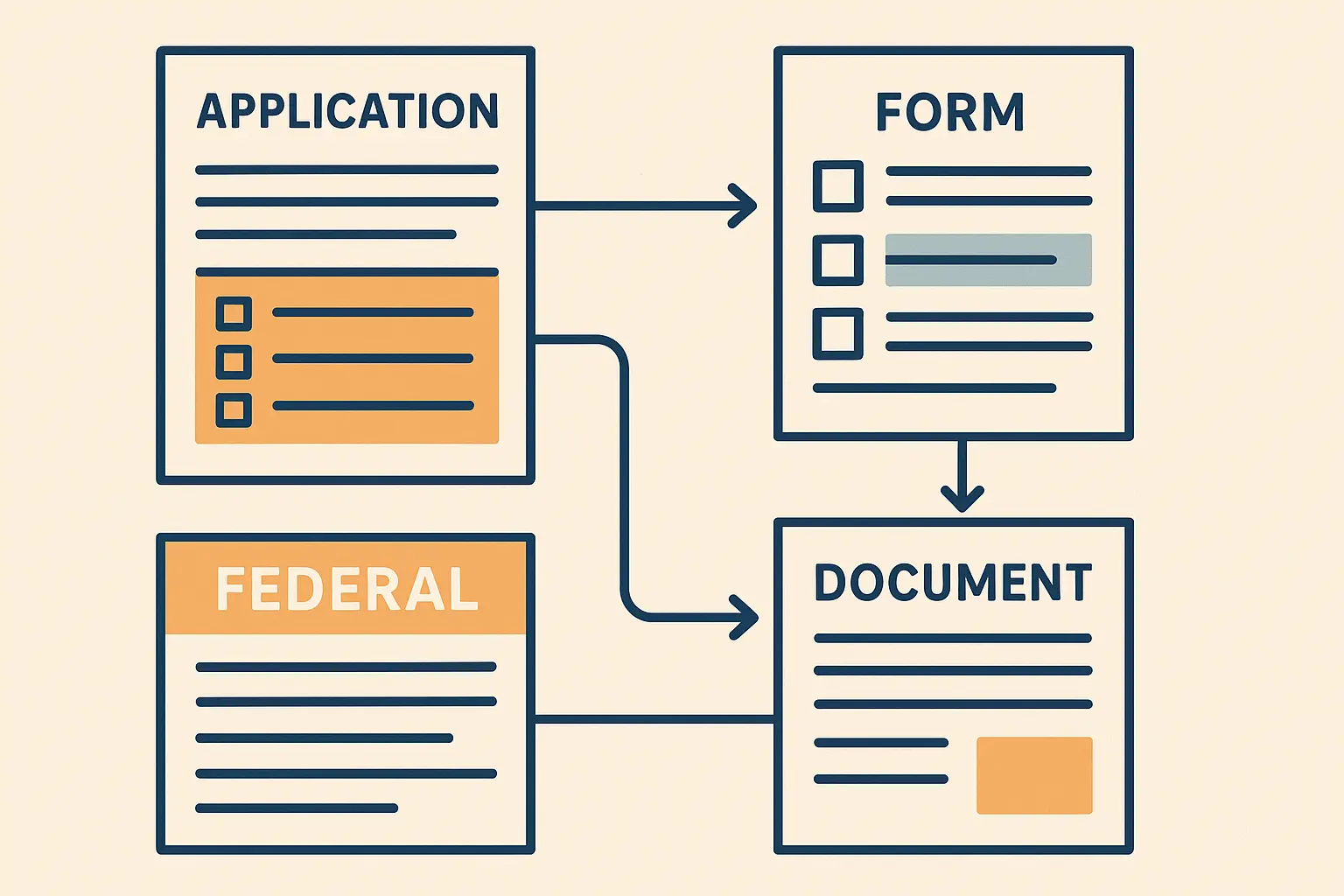Why Your Corporate Resume Will Bomb in Federal Hiring (And What Actually Works)

Look, I’ll be straight with you: everything you know about resume writing is wrong when it comes to federal jobs.
I learned this the hard way. After years of perfecting my sleek, one-page corporate resume, I confidently applied to a GS-13 position. Crickets. Not even a courtesy rejection email.
The problem? Federal hiring operates in a completely different universe. Where private companies want brevity, the government demands exhaustive detail. That’s why using the right federal resume template format is essential for presenting your qualifications correctly. Where corporate recruiters skim for keywords, federal HR specialists need proof of every qualification you claim.
Here’s what 2.95 million federal employees know that you don’t: success isn’t about having the right experience—it’s about presenting that experience in a way the government actually understands.
The Federal Resume Reality Check
Forget everything you’ve heard about keeping resumes short. Federal resumes traditionally run 3-5 pages because they have to. Government hiring managers need comprehensive information to make legally defensible decisions. A structured federal resume template format helps ensure you meet all compliance requirements without missing critical details.
This isn’t bureaucratic nonsense—it’s how agencies ensure fair evaluation while meeting strict compliance requirements. When I finally understood this, everything clicked.
But here’s a curveball: new OPM rules are flipping the script. “New OPM Rule Slashes Federal Resumes to Two Pages—Here’s How to Adapt” from ClearanceJobs reports that under the U.S. Office of Personnel Management’s Merit Hiring Plan released May 29, 2025, every vacancy announcement at GS-5 and above now starts with a resume capped at two pages. Talk about whiplash for those of us who’ve been writing novel-length federal resumes for years.
Here’s what’s actually different:
- Length matters: Your resume needs space to tell the whole story (or fit everything into two pages strategically)
- Details count: Hours worked per week, supervisor contacts, exact dates—all required
- Language shifts: Government terminology isn’t optional; it’s essential
- Structure is sacred: Missing sections = automatic disqualification
The Non-Negotiables Every Federal Resume Needs
Your federal resume isn’t just a work history—it’s a legal document. Miss any of these sections and you’re out before anyone reads past your name:
Contact Info That Goes the Distance:
- Full street address (not just city/state)
- Citizenship status
- Veteran preference (if applicable)
- Security clearance level and date
Work Experience That Proves Everything:
- Exact employment dates (month/year)
- Hours worked per week
- Supervisor’s name and contact info
- Salary (yes, really)
- Detailed job duties that match the target position
Understanding the fundamentals of effective resume structure is crucial before diving into federal-specific requirements. For those transitioning from private sector, reviewing professional resume format best practices provides a foundation for adapting to government standards. Before you dive in, it’s smart to study a proven federal resume template format so you know exactly where each section belongs.
The Government Wants Your Life Story (Almost)
Remember writing those college essays where every word counted? Federal resumes are the opposite. You need to spell out everything because hiring managers can’t assume anything.
Instead of: “Managed team projects”
Write: “Supervised a cross-functional team of 12 employees across three departments, managing $2.3M in project budgets while ensuring 100% compliance with federal acquisition regulations over 18 months.”
A proper federal resume header should include comprehensive contact information:
John Smith, GS-13 Program Analyst
5004 Ingrid Lane, Washington D.C., 20016, United States
Phone: (202) 362-7188 | Email: john.smith@email.com
Citizenship: U.S. Citizen
Special Hiring Authority: None
Federal Experience: Yes, Federal
Security Clearance: Secret (Current)
Why Security Clearance Is Your Golden Ticket
If you have any level of security clearance, highlight it prominently. Cleared candidates are gold in federal hiring because agencies don’t have to wait months for investigations.
Department of Defense positions often require additional security-related information:
Standard Federal Resume: Security Clearance: Secret (Current)
DoD-Specific Addition: Security Clearance: Secret (Current, reinvestigation due 2026), Polygraph: Counterintelligence (2023), CAC Card: Active, JPAS Access: Authorized
Speaking Government: Translation Required
Here’s where most people crash and burn. You can’t just copy-paste your corporate resume and hope for the best—you need to follow a federal resume template format designed for government language and structure. Government agencies have their own language, and if you don’t speak it, they won’t understand you.
The transition to shorter federal resumes is creating new challenges for experienced professionals. “How to Fit Your Whole Government Career and Executive Qualifications Into a Two-Page Resume” from Federal News Network explains that professionals who have grown up in the federal government, progressing from GS-5 or GS-7 up to GS-15, have been writing 5+ page resumes for years and now must completely reverse their thinking to fit everything into two pages.
Making Your Experience Sound Federal-Ready
The trick isn’t lying about your background—it’s presenting your real experience using terms federal hiring managers recognize and value.
Many professionals asking “how do I write a resume” for federal positions are surprised by the extensive documentation requirements that differ dramatically from private sector expectations.
According to Resume.io, the average annual pay for civilian federal workers exceeds $80,000 in all US states, with the highest paid professions including medical officers ($269,735 per year), securities compliance examiners ($210,689), dental officers ($202,333), administrative law judges ($192,546), and ship pilots ($183,500), demonstrating the significant career opportunities available for those who master federal resume writing.
Before: “Improved customer satisfaction”
After: “Enhanced stakeholder engagement through implementation of customer service protocols, resulting in 25% improvement in satisfaction metrics across 500+ client interactions annually”
Before: “Led marketing campaigns”
After: “Directed multi-channel outreach initiatives supporting agency mission objectives, coordinating with 5 departments to deliver messaging to 10,000+ constituents quarterly”
Quantifying Impact with Government-Relevant Metrics
Government hiring managers look for measurable results expressed in terms they understand: budget managed, people supervised, projects completed, and efficiency improvements. Focus on achievements that show your ability to manage resources, lead teams, and deliver results within complex organizational structures.
Weak: “Assisted in attracting and retaining workers.”
Strong: “Assisted in attracting and retaining a high-performing and diverse workforce, contributing to a 30% increase in retention rates across 150+ employees.”
Weak: “Helped to foster a diverse work environment.”
Strong: “Fostered a diverse and inclusive work environment, including execution of three programs that grew employee diversity by 10% over two fiscal years.”
Keywords That Actually Matter
Every federal job posting is loaded with specific terms. Your resume needs to echo this language naturally. Don’t just stuff keywords randomly—weave them into genuine descriptions of your work.
Study the job announcement like it’s scripture. Circle every qualification, skill, and buzzword. Then find authentic ways to incorporate these terms into your experience descriptions.
Conquering the USAJOBS Monster
USAJOBS isn’t just a job board—it’s a filtering system designed to weed out candidates before human eyes see your resume. Understanding how to work with (not against) this system can make or break your federal career dreams.
The federal government receives thousands of resumes for each position, making ATS optimization crucial. According to Resume.io, resumes that contain the desired keywords and phrases are green-lighted for further review, while those that fail automated screening may never be seen by human evaluators, highlighting the critical importance of proper keyword optimization when uploading my resume to federal systems.
Resume Builder vs. Upload: Choose Your Fighter
USAJOBS offers both a resume builder tool and document upload options, each with distinct advantages and limitations:
Resume Builder Pros:
- Plays nice with the system
- Formats correctly every time
- Easy to update for multiple applications
Resume Builder Cons:
- Limited formatting options
- Character limits can be brutal
- Looks like everyone else’s
Document Upload Pros:
- Complete control over appearance
- No character limits
- Can showcase your design skills
Document Upload Cons:
- Might not parse correctly
- Formatting can get mangled
- Riskier for ATS screening
My advice? Start with the resume builder for your first few applications. Once you understand how the system works, experiment with uploads.
Beating the Keyword Game
Federal hiring systems are ruthless keyword scanners. If your resume doesn’t contain the right terms, it gets filtered out before any human sees it.
But here’s the thing—you can’t just stuff keywords randomly. The system is smarter than that. You need to use terms naturally within context, showing not just that you know the buzzwords but that you understand what they mean.
Working Within Character Limits and System Constraints
USAJOBS imposes specific character limits on various fields, requiring careful editing and prioritization to ensure critical information fits within system parameters while maintaining readability.
Every character counts when you’re working within these limitations. I’ve developed techniques for condensing information without losing impact, such as using abbreviations for common terms and eliminating unnecessary words while preserving meaning.
Managing the Federal Job Hunt Like a Pro
Applying for federal jobs isn’t a one-and-done deal. You’ll be juggling multiple applications, each requiring customization. Here’s how to stay sane while maximizing your chances.
The fastest-growing jobs in the federal government are projected to be statisticians, medical workers, computer and data experts, and analysts, according to Resume.io, though there is an anticipated 2% decline in overall federal employment, making strategic application management even more critical for success in competitive federal job markets.
The Version Control System That Saves Your Sanity
Create a master resume with everything you’ve ever done. Then create targeted versions for specific job series or agencies. Use clear file names like “Resume_GS13_ProgramAnalyst_DOD_Jan2024.pdf”
Track what you customize for each application. When you start getting interviews, you’ll want to know what worked.
Playing the Numbers Game Strategically
Federal hiring moves slowly. Like, glacially slowly. Apply broadly but strategically. Don’t just throw your resume at every posting—target positions where you genuinely meet the qualifications.
Keep a simple spreadsheet tracking:
- Position applied for
- Application date
- Closing date
- Status updates
- Interview requests
The Waiting Game (And How to Win It)
Federal hiring timelines are brutal. Six months between application and hiring is normal. A year isn’t unheard of. Don’t put your life on hold waiting for responses.
Keep applying, keep improving your resume, and keep building relevant experience. The best time to apply for federal jobs is always now, because by the time you hear back, you’ll have even more qualifications to offer.
Data collection becomes invaluable when you’re applying to multiple positions over time. Track which resume versions generate interviews, what keywords seem most effective, and which agencies respond most favorably to your background.
Advanced Moves for Federal Career Success
Once you’ve mastered the basics, these strategies can give you an edge in the competitive federal job market.
Professionals from various sectors can benefit from understanding interview preparation alongside resume optimization. Those targeting banking-related federal positions should review common banking interview questions to align their resume content with expected competencies.
Targeting the Right Grade Level
Don’t undersell yourself, but don’t reach too far either. Federal grade levels have specific qualification requirements. Apply for positions where you clearly meet the criteria rather than hoping they’ll see your potential.
Federal positions operate under specific classification systems like GS (General Schedule) and WG (Wage Grade) that require your resume to demonstrate qualifications matching the targeted series and grade level.
Building Your
Building Your Federal Network
Federal hiring often involves internal candidates or referrals. Attend government conferences, join professional associations, and connect with current federal employees in your field.
LinkedIn is surprisingly useful for federal networking. Many government employees are active and willing to share insights about their agencies.
Agency-Specific Adaptations
Different federal agencies may have unique requirements or preferences for resume formatting, submission processes, and additional documentation that supplement standard federal resume guidelines.
Major departments like Defense, Homeland Security, or Health and Human Services may have specialized requirements reflecting their unique missions, security needs, or professional standards.
The New Two-Page Reality
With OPM’s new rules limiting many federal resumes to two pages, everything changes. You need to be surgical about what to include.
Priority 1: Direct experience matching the job requirements
Priority 2: Leadership and management experience
Priority 3: Education and certifications
Priority 4: Everything else (if space allows)
Use every formatting trick you know—tight margins, smaller fonts, strategic white space. Every character counts now. Choosing a concise federal resume template format makes it easier to trim content while still meeting OPM’s strict two-page cap.
Common Mistakes That Kill Federal Applications
Mistake 1: Treating it like a corporate resume
Government hiring is different. Respect the process.
Mistake 2: Ignoring the job announcement
Every word in that posting matters. Address every requirement.
Mistake 3: Being too modest
Federal resumes aren’t the place for humility. If you did it, claim it.
Mistake 4: Missing deadlines
Federal deadlines are absolute. Late applications don’t get considered.
Mistake 5: Giving up too early
Federal hiring is a marathon, not a sprint. Persistence pays off.
Your Federal Resume Action Plan
Ready to tackle federal job hunting? Here’s your roadmap:
- Research first: Understand the agencies and positions you’re targeting
- Master the format: Get comfortable with federal resume requirements
- Customize ruthlessly: Every application needs tailoring
- Track everything: Stay organized across multiple applications
- Be patient: Federal hiring takes time, but the rewards are worth it
Federal employment offers stability, excellent benefits, and the chance to serve the public interest. The resume process is complex, but it’s not impossible. Once you understand the rules, you can play the game effectively.
Resume Builder IQ’s AI-powered platform addresses many of the complex challenges federal job seekers face. The platform’s ATS optimization ensures your federal resume passes initial screening systems, while AI writing tools help translate your experience into government-appropriate language with proper terminology and quantified achievements. The customizable templates adapt to federal formatting requirements, and keyword optimization features help align your resume with specific job announcements and competency requirements.
If you’re overwhelmed, start with a reliable federal resume template format that guides you step by step. Ready to transform your federal job search? Try Resume Builder IQ’s federal resume optimization tools and see how AI can streamline your path to government employment.
The key is treating federal resume writing as a skill to master, not a hurdle to overcome. With practice and persistence, you’ll crack the code and open doors to a rewarding government career. The complexity can feel overwhelming at first, but remember that these requirements exist for good reasons—they ensure fair evaluation, legal compliance, and help agencies find candidates who truly understand government operations. Once you master the federal resume format, you’ll have a significant advantage in pursuing government career opportunities that offer stability, benefits, and the chance to serve the public interest.

